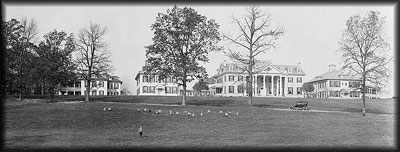Crownsville State Hospital for the Negro Insane in Maryland
Built in 1910; quickly renamed from “Hospital for the Negro Insane” by an act of Maryland’s legislature, closed in June, 2004.
“Thirty-one male Negro mental patients from Montevue Asylum in Frederick county were to clear the land and build a railroad spur to the hospital site. Arriving first in handcuffs and guarded by a dozen deputy sheriffs, the men were told to expect different treatment that would not confine them to cells or handcuffs or straight jackets.’ Each man was issued an axe. With three orderlies, Dr. Robert J. Winterode, Superintendent of Crownsville, worked with the ‘dangerously insane’ Negroes, cutting hundreds of crossties and tall poles for the electric wires…that was just the beginning of the fun.” –Someone you don’t know
“There has been nothing of greater importance to the State … than the laws enacted for the care and treatment of the insane in Maryland.” –25th Annual Report of the Lunacy Commission, 1910 [Did you read that? Maryland had a “Lunacy Commission” — that’s just crazy.]
Positively inspirational. Equally unsettling. Interestingly, the Crownsville site and the Rennaissance Festival site are neighbors.
As of Jan 2005, Maryland operates two state mental hospitals, Spring Grove Hospital in Catonsville (Baltimore county) and Springfield Hospital in Sykesville (Carroll county), via the Mental, uh, Maryland Hospital Authority, or, er, uh, Mental Hygiene Administration (MHA) link.
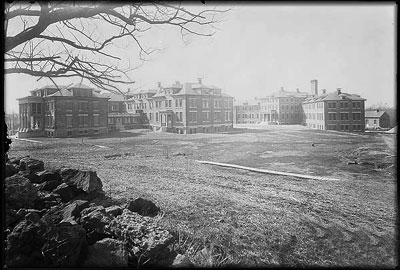
“There is a separate building for the Negroes. This building is, without doubt, the worst of kind within the state.”
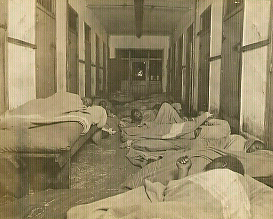
Maryland Mental History
Spring Grove Hospital in Baltimore County, Springfield Hospital in Carroll County and Crownsville Hospital in Anne Arundel County. The MHA operated approximately 1,200 psychiatric beds and employs 3,100 individuals. Each of the regional hospitals have multiple tenants on their grounds and each host clinical training programs.
Over the past two decades, MHA has reduced its beds by 4,000 or 73%. Although the MHA operates 1,200 beds, 50% of those beds are forensic and are occupied by individuals who are court ordered for competency and responsibility evaluations or committed for treatment upon a finding of incompetent to stand trial or not criminally responsible due to a mental disorder. The reduction in the number of beds is a result of improved medications and growth in community-based services in response to the Supreme Court?s Olmstead decision.
The review process included a data-driven study of issues by hospital leadership that examined all of the Central Maryland Regional Facilities. All agreed that their goal was to maintain or improve the quality of care, maintain current bed capacity and achieve capital and operating savings. It was important to maintain current bed capacity, as the courts are still committing people at record numbers and there are backlogs in the hospital emergency rooms. The MHA would like to create more community placements, however, there are no funds available at this time.
There were many issues to consider when consolidating, the first, was the patients. This closure was going to cause disruption to their treatment and their support system. There was concern regarding the impact on family, staff and the community. There are legal concerns, one half of the population are court involved. There are also tenant issues as well as programming capacity and ongoing operating issues. Crownsville was chosen because the least number of patients would be affected, Crownsville had fewer state agencies on their campus and posed the least number of potential layoffs.
Ms. Sheilah Davenport, CEO, Crownsville Hospital, informed the Committee that the hospital has been in existence since 1910 and had 200 patients when the consolidation process began and currently has 82 patients remaining, all of whom will be transferring to Springfield or Spring Grove Hospitals by June 30th. At the beginning of the process, there were 468 employees, 109 were given notice that they will not be given a placement in another MHA hospital. The people not placed were administrative and support staff. Due to a consorted effort by DHMH Human Resources, all but 12 of that 109 people have been given placements in other state agencies and those 12 have been given layoff notices. Personnel continues to work on finding these people placements. All clinical staff were reassigned to either Spring Grove or Springfield Hospitals and moved primarily with their patients to maintain continuity. The consolidation process has gone relatively smoothly and took the concerns expressed by families very seriously and moved patients to the facilities that they or their family had requested.
It is still unclear as to what will happen to the campus. Anne Arundel County is interested in acquiring the property. A skeletal crew will remain behind on the premises to make sure the property remains safe and is maintained.
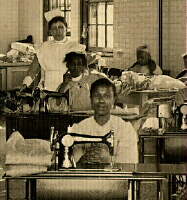
RAND JURY INSPECTIONS OF STATE HOSPITALS AND SCHOOLS by Pat Melville
[Continuation of analysis of ANNE ARUNDEL COUNTY CIRCUIT COURT (Grand Jury Reports) 1933-1966 [MSA C2137] and ANNE ARUNDEL COUNTY BOARD OF EDUCATION (Grand Jury Reports) 1969-1981 [MSA CM1178].]
The Anne Arundel County grand juries inspected the state hospitals and schools in the county. The committees looked at both the physical plant and the administration of each facility. The institutions included Crownsville State Hospital, Clifton T. Perkins State Hospital, and Barrett School for Girls.
Crownsville State Hospital was established in 1910 to house and care for insane persons among the African American population within the state. It was desegregated in 1949. Throughout the 1940s the grand jury lamented the practice of placing criminally insane and older, senile people in the hospital. In the 1950s the grand jury reports referred to periodic riots which were blamed on operating the facility both as a mental hospital and a penal institution. Overcrowding necessitated the mixing of the two types of patents. In 1955 the patent population reached 2600. Some buildings were jammed full of beds and others contained individual bedrooms and commodious day rooms.
As with the penal facilities, the grand jury of the April 1965 Term conducted a very thorough examination of the Crownsville State Hospital and reported their findings in detail. By then most of the patients were coming from a specific geographical area, specifically southeast Baltimore, Anne Arundel County, and Southern Maryland. A Community Psychiatric Center provided out-patient treatment of mental disorders. An Alcoholic Rehabilitation Unit treated alcoholics who admitted themselves or had been committed by a judge, family, or friends. The unit experienced a high return rate because community based out-patient clinics were unavailable. The grand jury inspection included training opportunities for patients which involved home economics, manual arts, upholstery, shoe repair, cosmetology, clerical work, reproduction and duplication, custodial services, food services, sewing, painting, nurses aide, and horticulture. The jurors presented several recommendations for the hospital, such as recruitment and inducement pay for psychiatric aides, removal of some geriatric patients to nursing homes, improved methods for treatment of alcoholism, means to transport visitors without cars, and private offices with air conditioning for doctors.
In 1976 the grand jury reported that “patient care appeared inadequate, facilities seemed in disrepair and in need of replacement or refurbishment…, the number of personnel on duty seemed limited [with] a very low level of morale on the part of the patients.” A formal inquiry was deemed unnecessary since a consultant had already been hired to investigate hospital management. By 1981 the jury was pleased to note immense improvement at the hospital.
The Clifton T. Perkins State Hospital was established in 1959 as a maximum security facility for mentally ill prisoners and other psychiatric patients needing secure confinement. The grand jury devoted few resources to this facility, and in 1966 described it as a small hospital with few problems.
The Barrett School for Girls began as a private school in 1882 and was purchased by the State in 1931 for African American female juvenile delinquents. The school seemed to average between 60 and 70 residents. Periodically the grand jury would criticize the operating expenses, especially personnel. In 1953 the teacher to student ratio was one to seven, contributing to an annual cost of $3000 per resident. The equivalent cost at Crownsville was $1000 per inmate and in the county schools was $175 to $225 per pupil. In 1955 the jury called attention to physical problems at the school, such as worn floor coverings, old kitchen sinks, missing or damaged screen doors, peeling paint, and battered dining room furniture. Three years later repairs were completed. In 1963 the Barrett School merged with and moved to the Montrose School for Girls.
At the local level the grand jury intermittently inspected the Anne Arundel Hospital between 1933 and 1941 and health centers in 1948 and 1957-1958, and usually adjudged them in good condition. The 1933 report noted the upcoming elimination of student nursing classes at the former facility because of a surplus in the profession and insufficient experience garnered at a small hospital.
1520 Crownsville Rd., Crownsville, MD 21032 — right across the road from the Maryland Rennaissance Festival. Hmmm.
Historians Work To Honor Mental Hospital Patients
Thousands Buried In Overgrown Grave
POSTED: 4:53 pm EST February 27, 2004
ANNAPOLIS, Md. — There is a cemetery just outside of Annapolis that carries the sad remains of a time when the mentally ill had few allies and even fewer opportunities for a normal life.
Crownsville Hospital
Buried there are more than 2,000 African-Americans who were the original patients at a place once called the Hospital for the Negro Insane, now known as Crownsville Hospital.
The state wants to close the hospital to save money. That has prompted an Annapolis historian to start a crusade to save the cemetery and the memory of those buried there.
It was not easy being black at the turn of the last century, and even harder for the mentally ill. The white hospitals didn’t want them, and, in many cases, neither did their families.
In 1911, in the spirit of reform, the state of Maryland created the Hospital for the Negro Insane, which gathered these outcasts in one place. It was considered progressive.
There, in the hands of white doctors and nurses, they were subject to the new therapies, like soaking in freezing water, being swaddled in hot blankets and solitary confinement.
When the depression hit, it became overcrowded. Young boys were placed in wards with older men who would sexually abuse them.
Patients slept two to a bed. The staff was overwhelmed. Patient logs show people dying from infected bed sores and gangrene.
The sick could not be isolated. Tuberculosis was rampant.
For many, the abuse continued after death, as some were taken to the University of Maryland Medical School and used as cadavers.
The rest were buried on an overgrown hillside behind the hospital, under stones as broken and sad as the lives that ended there.
“(There are) no names, just numbers. They need someone to speak for them,” said Janice Hayes-Williams.
Hayes-Williams and social worker Paul Lurz have become the voice for the 2,400 souls.
As the descendent of Annapolis slaves, Hayes-Williams believes the lives of these people must be noted for their descendants.
“People need to know their family members are there,” Hayes-Williams said.
She and a group of volunteers are now combing through the state records, determined to learn who died there, so a monument can be created with all their names.
“(It’s) a memory to their trauma, their difficult lives, the hardships they endured here. I don’t think, as a society, as a people, we should forget that,” Lurz said.
It’s said that the manner in which a community cares for its dead reflects the tender mercies of its people.
Hayes-Williams and Lurz periodically clear the dead leaves and debris from the fading stones and hope that the patients buried in the graveyard will finally be granted some small measure of dignity and kindness.
Anyone wanting more information about the project can contact Hayes-Williams at ourlocallegacy@aol.com or Lurz at (410) 729-6526.
adapted from nbc4.com
Historic mental hospital closes
by Robert Redding Jr.
THE WASHINGTON TIMES
Published June 29, 2004
When the last handful of mentally ill patients leave Crownsville Hospital Center today, the state of Maryland will close the doors on a nearly century-old facility, leaving behind an empty building — and a potter’s field of unmarked graves holding the remains of the hundreds of mostly black patients.
“The graves and the burial site will be retained, maintained and treated with the kind of dignity and respect that one would expect,” said state Health Secretary Nelson J. Sabatini. He said the Anne Arundel County hospital, formerly known as the Hospital for the Negro Insane, will historically preserve roughly 500 acres of the 1,200-acre campus, where 1,800 graves of the hospital’spredominately black former patients are located.
The hospital — which at one time housed 1,300 patients annually with a ratio of one doctor to 225 adults and children in buildings meant for 1,100 — is shutting its doors this week to save taxpayers $12 million a year. Its patient population peaked in 1955 at 2,719.
Today, the last of its 200 patients will be transferred to the state’s two remaining treatment facilities at Spring Grove Hospital Center in Baltimore County and Springfield Hospital Center in Carroll County — largely because of advances in psycho-pharmaceutical medicine that enables a shift away from warehousing those with mental illnesses.
“This is about restructuring the delivery system to make it more efficient,” said Mr. Sabatini, who added the mental health system will continue treating the same number of patients. He said the remaining nonprofit organizations renting space on the hospital grounds will be allowed to stay until government officials exercise first options on the land or until a private company buys the land.
The hospital, established by the General Assembly in 1910, began operation the next year, and was renamed Crownsville State Hospital in 1912.
Although the hospital was built to be a service to the mentally ill, patients who were lost, were homeless or had syphilis and tuberculosis also ended up there.
After death, many of the bodies either were claimed by family, buried in private cemeteries or sent to Baltimore for brain experiments (Johns Hopkins).
Staffers, however, buried an estimated 1,800 people on the grounds. About 1,400 are in unnamed graves, marked with numbers to protect their families’ identities.
Historians have been working for three years to complete identification — difficult because many of the headstones did not have names on them until 1953.
Mr. Sabatini said the closing will create a more efficient system enabling the state to direct $5 million into community-based programs for the mentally ill. The state also has set aside another $1 million to maintain the campus. “That was very old facility that required a great deal of maintenance,” he said. “It would have required some significant capital investment in the very near future.” He said that nearly all of the 490 Crownsville employees have found new jobs and that the remaining eight are being assisted with employment.
But Sandy Bellamy, executive director of the Reginald F. Lewis Museum of Maryland African American History and Culture in Baltimore, is concerned that the institution’s heritage be preserved. “Our first concern is to protect the documents and photographs — any tangible artifacts of history,” she said. Mr. Sabatini agreed. “Crownsville occupies a unique place in American history,” he said. “We are going to preserve archives and memorabilia to make sure they are appropriately preserved.”
This article is based in part on wire service reports. adapted from washingtontimes.com
Overview
Crownsville State Hospital, originally established in 1911 as the Hospital for the Negro Insane of Maryland, was created to provide separate psychiatric care for African American patients during a time of segregation. Located in Crownsville, Maryland, the facility was built on a 556-acre farm and was largely self-sustaining, with patients contributing labor to farming and construction activities. (savingplaces.org)
Throughout its history, the hospital faced significant challenges, including overcrowding, understaffing, and inadequate facilities. At its peak in 1955, Crownsville housed 2,719 patients, far exceeding its intended capacity of 1,100. Conditions were often dire, with reports of patients being used for medical experiments and subjected to unpaid labor. (savingplaces.org)
The hospital was eventually integrated, and over time, the patient population declined. In 2004, after years of deteriorating conditions and a shift towards community-based mental health care, Crownsville State Hospital was closed. (savingplaces.org)
Since its closure, the site has remained largely abandoned, with many of its buildings falling into disrepair. There have been ongoing discussions about repurposing the property, with proposals to transform it into a center for nature and healing, aiming to honor its complex history while providing community benefits. (cbf.org)
For a visual overview of the site’s transformation efforts, you might find this video informative:
Maryland mental health hospital ‘Crownsville’ transformed
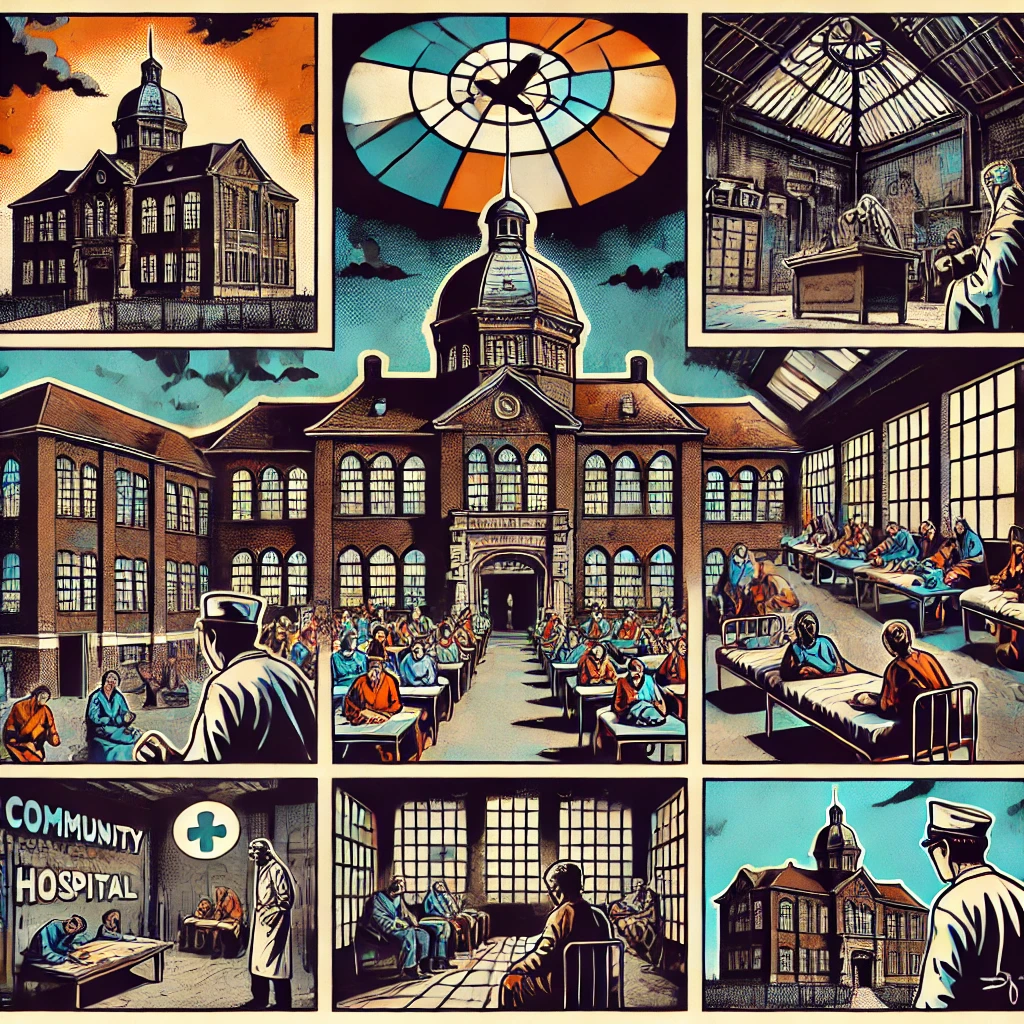
The Haunting Legacy of Crownsville State Hospital in Ellicott City, Maryland
Nestled deep in the woods of Ellicott City, Maryland, the abandoned Crownsville State Hospital stands as a silent testament to its dark and troubled past. Once a place intended to provide care, it now harbors an eerie presence, shrouded in mystery, sorrow, and ghostly sightings.
The Closing and Abandonment
Crownsville State Hospital, originally established in 1911, served as a psychiatric facility for African American patients during segregation. Over the decades, it became notorious for overcrowding, neglect, and reports of inhumane treatment. By the late 20th century, the hospital struggled with dwindling resources, outdated facilities, and a shift in mental health care that favored community-based treatment. These factors ultimately led to its closure in 2004. Since then, the once-bustling grounds have deteriorated, leaving behind crumbling walls, empty corridors, and whispers of a tortured past.
Haunted Sightings and Paranormal Activity
The abandonment of Crownsville has not erased the lingering spirits that many believe still reside there. Paranormal investigators, thrill-seekers, and urban explorers report frequent encounters with the unknown:
- Echoing Screams in the Woods – Many who venture near the hospital at night claim to hear distant cries and blood-curdling screams from the surrounding forest. Some believe these are the echoes of former patients who suffered within its walls.
- Apparitions in the Hallways – Shadowy figures and ghostly apparitions have been sighted walking through the crumbling corridors. Some appear as former doctors and nurses, while others are believed to be long-lost patients.
- Unexplained Cold Spots and Flickering Lights – Despite being abandoned for years, visitors report sudden temperature drops, inexplicable flickering lights, and strange electromagnetic disturbances near old treatment rooms.
- Disembodied Voices and Spirit Communications – Ghost hunters using spirit boxes and EVP (Electronic Voice Phenomena) devices claim to have recorded voices crying out names, asking for help, or whispering unintelligible phrases.
Theories Behind the Hauntings
The reasons for the hospital’s intense paranormal activity remain a topic of speculation. Some believe the suffering of patients, the history of medical experiments, and even rumored unmarked graves have left an imprint of energy that refuses to fade. Others suggest that spirits of past residents, unable to find peace, still wander the halls searching for closure.
Urban Legends and the Future of Crownsville
The abandoned hospital has become the center of ghost stories, fueling local legends of tortured souls trapped between realms. Some say a malevolent entity roams the grounds, preying on those who dare to enter. Others believe spirits of former caregivers still attempt to protect the place they once served.
While various plans have been proposed for repurposing the site, the deep-rooted hauntings and structural decay continue to make redevelopment a challenge. Until then, Crownsville remains a chilling reminder of Maryland’s complex history with mental health institutions—and a hotspot for those seeking encounters with the unknown.
